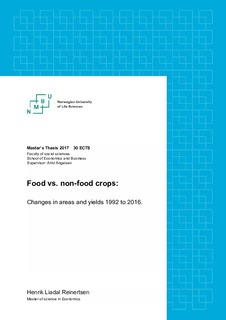| dc.contributor.advisor | Angelsen, Arild | |
| dc.contributor.author | Reinertsen, Henrik Liadal | |
| dc.date.accessioned | 2018-10-10T11:59:00Z | |
| dc.date.available | 2018-10-10T11:59:00Z | |
| dc.date.issued | 2018 | |
| dc.identifier.uri | http://hdl.handle.net/11250/2567425 | |
| dc.description.abstract | Changing demand for different agricultural products causes shifts in land use. Until recently, food production was the main agricultural practice for most countries. Today, producing nonfood crops, exclusively is on the rise. This growth, along with increasing per-capita food consumption, will require large increases in crop production. However, agricultural productive land is scarce and increase in demand are modified by the yield increase. This thesis aims to explore links between production of staple crops and demand for non-food crops and discusses if higher yield enhances or reduces total agricultural area.
Following a presentation on the literature is a discussion on theories of land use, introducing von Thünen’s theory of land rent. Considering this theory, I present the debate on the impacts of higher agricultural productivity, known as the Borlaug hypothesis vs. the Jevons paradox. To dig deeper into on our research question, a dataset based on the UN Food and Agricultural Organization database and the World Bank Databank was constructed. Previous information on the distribution and performance of specific crops have only been available through remote sensing. However, a new detailed dataset, where the distribution of crops’ area of usage is taken into consideration, improves the analysis environmental impacts and trends in agricultural land use.
In this thesis, descriptive statistics and regressions analysis indicates two major findings. First, expansion of agricultural area from 1992-2016 has mainly been caused by increase in feed crop area, however staple crops area has also been a large contributor, especially in low/ middleincome countries. Further, feed-, fuel- and non-food crops has experienced the largest relative growth, indicating the direction of trends in agricultural production. Second, higher staple-crop yield reduces crop area, as suggested by the Borlaug hypothesis, while higher feed -and fuel crop yield increases crop area, as suggested by the Jevons paradox. | nb_NO |
| dc.description.abstract | Endringer i etterspørselen for jordbruksprodukter fører til endringer i arealbruk. Frem til nylig var matproduksjon den viktigste landbrukspraksisen i de fleste land. I dag er det imidlertid en tendens til å produsere avlinger utelukkende for markedet. Denne veksten, sammen med økende matforbruk per person, krever stor vekst i avlinger. Egnet landbruk areal er imidlertid en mangelvare, og effekten av økt etterspørsel er modifisert av produktiviteten i landbruket. Denne oppgaven analyserer sammenhenger mellom produksjon av de viktigste avlingene og etterspørsel etter avlinger produsert utelukkende for markedet, og diskuterer om høyere jordbruksproduktivitet øker eller reduserer totalt landbruksareal. Etter en presentasjon på litteraturen presenteres landbruksteorier som kombinerer von Thünen’s teori om grunnrente. I lys av denne teorien presenterer jeg debatten om virkningen av høyere jordbruksproduktivitet, kjent som Borlaug-hypotesen vs. Jevons paradoks. For å gjennomføre detaljerte analyser ble det laget et datasett basert på data fra FNs Mat og Landbruksorganisasjon (FAO) og Verdensbanken. Tidligere studier på distribusjonen og produktiviteten av spesifikke avlinger har kun vært tilgjengelig gjennom fjernmåling. Et nytt og detaljert datasett, hvor bruksområdene til avlingene er tatt i betrakting, har derfor blitt ekstrahert for å forbedre kvaliteten og mulighetene til å analysere miljøpåvirkningene og endringer i landbruket.
Analysen gir to hovedfunn. For det første er utvidelsen av landbruksarealet fra 1992-2016 hovedsakelig forårsaket av økning i produksjon av dyrefôr, i tillegg til basis-matvarer, spesielt i lav- og mellominntektsland. Videre har dyrefôr, biodrivstoff, og ikke matvarer opplevd den største prosentvise veksten i jordbruksareal. For det andre vil høyere produktivitet for basismatvarer redusere jordbruksarealet, som foreslått i Borlaug-hypotesen, mens høyere produktivitet for fôr- og biodrivstoff gir økt jordbruksareal, som foreslått av Jevons paradoks. | nb_NO |
| dc.language.iso | eng | nb_NO |
| dc.publisher | Norwegian University of Life Sciences, Ås | nb_NO |
| dc.rights | Attribution-NonCommercial-NoDerivatives 4.0 Internasjonal | * |
| dc.rights.uri | http://creativecommons.org/licenses/by-nc-nd/4.0/deed.no | * |
| dc.title | Food vs. non-food crops : changes in areas and yields 1992 to 2016 | nb_NO |
| dc.type | Master thesis | nb_NO |
| dc.description.localcode | M-ECON | nb_NO |

